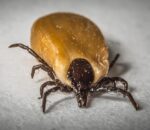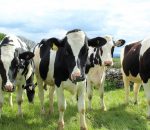(Other common names include Aphthous fever, Vesicular aptha, Panzootic aptha)
Foot and mouth disease is a highly contagious disease of the cloven-footed animals. It is characterized by vesicular formations in the epithelium of the oral cavity, udder, muzzle, teats, and feet (hoofs). In calves, there is focal degeneration of cardiac and skeletal muscles which often leads to death. Foot and mouth disease (FMD) in cattle causes considerable economic loss as the recovered animal shows a marked reduction in the milk, meat, and working capabilities.
The causative agent is Apthovirus, which is an infectious, positive sense, ss-RNA virus. There are 7 serotypes of the virus: Types O, A, C, South African Territories 1, 2, and 3 (SAT-1, -2, -3) and Asia-1. Large numbers of subtypes were also identified. Infection with one serotype does not confer immunity against another. Foot and mouth disease occurs naturally in cloven-hoofed animals (Both domestic and wild animals). The healthy animals are infected by contact with the secretions and excretions of the FMD-affected animals.
Clinical Signs
- Pyrexia (104°F) is accompanied by generalized malaise, depression, dejection, and apathy toward food and water.
- Vesicular development on gums, lips, tongue, hard palate, muzzle, coronary band, interdigital cleft, and teat in lactating cows.
- Drooling of foamy, soapy salivation, and protrusion of the tongue are common signs.
- Animal refuses to eat due to pain in the oral mucosa.
- In acute cases, animals salivate profusely, stamp their feet, and prefer to lie down.
- Secondary bacterial mastitis is common.
- Lameness
- Death occurs in immature sheep & goats without manifesting clinical signs due to heart failure.
- Suckling calves usually die as a result of myocarditis and myocardial degeneration.

FMD Treatment
There is no specific treatment for FMD. Symptomatic treatments may be rendered depending on clinical manifestations of animals during foot and mouth disease.
- Any NSAID or antipyretic drug should be used to manage the extreme conditions of the fever.
- Antibiotics are administered to avoid the chances of secondary bacterial infections.
- Antiseptics mouth wash with potassium permanganate, sodium carbonate, boric acid, and glycerine may be applied over mouth lesions as well as on lesions of teats and hoofs.
- The diet of the animal should be strictly monitored as the animal avoids eating anything. A soft and energy-rich diet should be offered. Supportive therapy will also be needed to overcome the energy deficiency and support the immune system of the animal.
Control & prevention (FMD Management)
The control measures vary from region to region and depend upon different factors.
The following points may be taken into consideration in an enzootic area where the outbreak is imminent.
- Restrict the movements of animals through proper regulation.
- Do not purchase or transport an animal from FMD prevailing area to a disease-free region/village.
- Vaccination of all the animals within the boundary of a village/farm should be done at one time. It is not rational to vaccinate animals of the same village/farm on different dates.
- Only vaccinated animals should be brought to a farm. Newly arrived animals should be kept in quarantine for 14-20 days.
- Always purchase fodder from a place where FMD has not been recorded for a period of the last 6 months.
Instructions to be considered following the outbreak of FMD
- Isolate the affected animal from healthy animals immediately after detection.
- Affected animal should not be allowed to graze on pastures or drink water from open streams or ponds. It may contaminate these resources and help in spreading the disease.
- In case of an outbreak, healthy animals should be attended to first and then the affected ones. Utensils used for milk collection or feed provision should be cleaned with a 4% sodium carbonate solution.
- Calves should not be allowed to suckle affected mothers and they should not be fed with the milk of affected animals.
- Wash the mouth of affected animals with antiseptic solutions. 1% potassium permanganate solution may be applied 3-4 times a day. Povidone-iodine 2-5% solution may also be used.
- Wash the feet of affected animals with a 2% copper sulfate solution. Antiseptic lotions and fly repellents should be used to eliminate the risk of infection and maggot formation in the wound.


